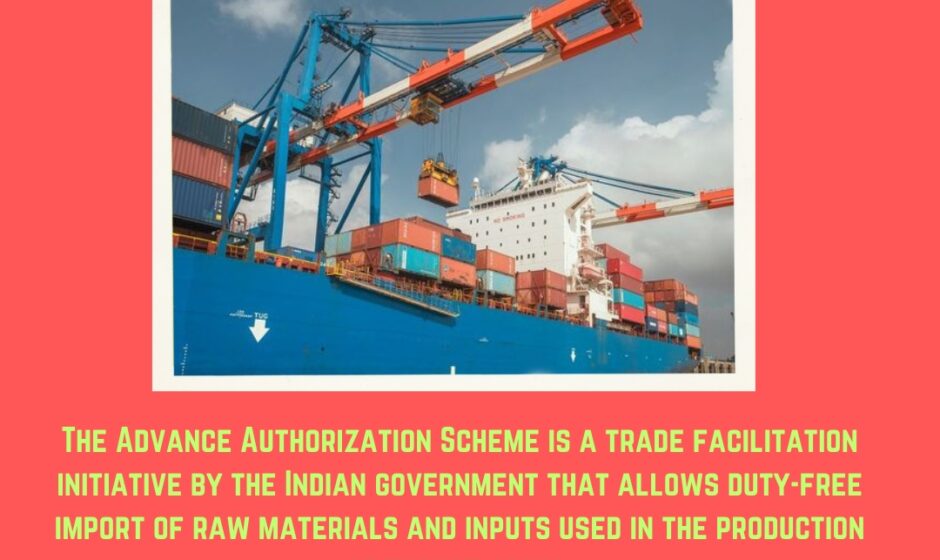The Advance Authorization Scheme is an initiative under India’s Foreign Trade Policy that plays a pivotal role in promoting export-led growth. This scheme provides duty-free importation of raw materials, inputs, and other components required to manufacture export products. Its flexibility and appeal come from its ability to reduce production costs for exporters, helping them compete globally. Let’s explore how this scheme works, its benefits, eligibility, and its significant impact on Indian exporters.
Key Features of the Advance Authorization Scheme
- Duty-Free Import of Inputs: Exporters can import inputs such as raw materials, consumables, and intermediates without paying duties or taxes. This feature is especially beneficial for manufacturers who require significant quantities of imported components in their production.
- Standard Input-Output Norms (SION): The Directorate General of Foreign Trade (DGFT) has defined a set of norms known as SION, which specify the amount of input required to produce a given unit of export product. These norms help in determining the permissible quantity of inputs for duty-free import under the scheme.
- Pre-Export and Post-Export Options: The scheme provides flexibility for exporters with two options: Pre-Export (the raw materials are imported before the export) or Post-Export (the raw materials are imported after the goods are exported). This allows exporters to align their import and export schedules according to their business needs.
Eligibility for the Advance Authorization Scheme
The AAS is available to manufacturers, processors, and job workers engaged in the production of goods for export. Specific eligibility criteria include:
- Manufacturer Exporters: Firms that manufacture goods and then export them are eligible.
- Merchant Exporters tied with supporting manufacturers: In this case, the merchant exporter collaborates with a manufacturer who will produce the export items.
- Job Workers: Job workers who process or manufacture on behalf of other exporters can also apply under AAS.
Benefits of the Advance Authorization Scheme
- Improved Cash Flow: AAS ensures that exporters do not have to pay taxes upfront on raw materials, which helps in improving cash flow and freeing up capital for other essential business activities.
- No Need for GST Payment: Since the inputs are exempt from IGST, exporters save on taxes, thereby improving their financial efficiency and liquidity.
- Supports Export Growth: By providing a duty-free environment for the import of raw materials, the scheme encourages the growth of industries that are dependent on imported components, such as electronics, pharmaceuticals, and engineering.
Challenges and Compliance Requirements
Although the Advance Authorization Scheme offers substantial advantages, it is not without challenges. Exporters must comply with strict documentation, reporting, and procedural requirements.
- Adherence to SION: Exporters must meticulously calculate their input-output ratios based on the SION norms and ensure compliance. Any deviation from these standards could lead to penalties or rejection of applications.
- Time-Bound Export Obligation: Exporters are required to fulfill their export obligation within a specified time frame, usually 18 months. Failure to do so can result in penalties and demands for duty repayment.
- Complicated Documentation: Exporters must maintain detailed records of all imported inputs, production processes, and exports. The documentation process can be complex, requiring significant administrative effort.
How to Apply for Advance Authorization
Exporters must follow these steps to apply for the Advance Authorization Scheme:
- Authorization Issuance: Once the application is approved, the DGFT issues the Advance Authorization license, which can then be used to import raw materials without paying duties.
- Export Obligation Fulfillment: After receiving the raw materials, exporters must fulfill their export obligation by exporting the goods within the specified time. They must also submit proof of export to the DGFT.
- Redemption and Closure: Upon completion of the export obligation, exporters must submit export documents and shipping bills to the DGFT. The authorization is then redeemed, and the case is closed.
The Impact of AAS on Indian Exporters
The Advance Authorization Scheme has proven to be a critical driver for various industries in India, particularly those that rely on imported components for production. Sectors such as pharmaceuticals, chemicals, automobiles, electronics, and textiles have benefitted immensely from the scheme. For instance, the pharmaceutical industry, which often requires the importation of active pharmaceutical ingredients (APIs), has experienced significant growth due to reduced production costs under AAS.
Conclusion
The Advance Authorization Scheme is a key enabler of India’s export growth, offering duty-free import benefits that lower production costs and boost the global competitiveness of Indian manufacturers. By providing a streamlined and flexible approach, the scheme supports the entire export value chain, from raw material importation to the fulfillment of export obligations. Despite some compliance and administrative challenges, AAS remains an invaluable tool for exporters, ensuring that they can compete in international markets while fostering industrial development within the country.



